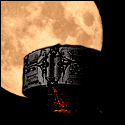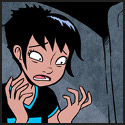|
Cainer posted:Nah you're not twisting my words around, I just don't know how to explain my points well enough. Wizards have their own weakness's and strengths, like fighters should have their own strengths and weakness's. Like wiards having less survivability what with fewer HP and AC. If a fighter gets swarmed by say... gobos, he has a good chance of surviving if he has decent arms and armor. If a wizard gets surrounded, they are usually pretty screwed unless they have the exact correct spells for the situation. Well, if you wanted to be anal about the rules, the Fighter actually stands a good chance of losing against said gobbos because the game lacks any sort of swarm or unit rules for groups like that, meaning they bust the action economy. Thanks to bounded accuracy/AC rules in 5e, they still stand a chance of actually hitting a Fighter even at 20th level. Throw enough gobs at him and he'll stand a good chance of dying. At lower levels this is especially true because damage vs HP values are skewed as all hell toward the monster entries downing players in 2-3 hits tops. So.. they're all equally hosed unless you start giving martials means to wipe out hordes on their own. Casters are more than suited this, by default. Strength of Many fucked around with this message at 01:59 on Sep 2, 2014 |
|
|
|

|
| # ? May 15, 2024 16:49 |
|
Strength of Many posted:Well, if you wanted to be anal about the rules, the Fighter actually stands a good chance of losing against said gobbos because the game lacks any sort of swarm or unit rules for groups like that, meaning they bust the action economy. Thanks to bounded accuracy/AC rules in 5e, they still stand a chance of actually hitting a Fighter even at 20th level. Throw enough gobs at him and he'll stand a good chance of dying. At lower levels this is especially true because damage vs HP values are skewed as all hell toward the monster entries downing players in 2-3 hits tops. Well like I said earlier, I have yet to play. Just basing my opinions on previous games in pathfinder/3.5 where the fighter was basicly the parties rock. He soaked up the damage, beat up the badguys and kept my wizard from being made into stew when he was out of gas.
|
|
|
|
Cainer posted:Nah you're not twisting my words around, I just don't know how to explain my points well enough. Wizards have their own weakness's and strengths, like fighters should have their own strengths and weakness's. Like wizards having less survivability what with fewer HP and AC. If a fighter gets swarmed by say... gobos, he has a good chance of surviving if he has decent arms and armor. If a wizard gets surrounded, they are usually pretty screwed unless they have the exact correct spells for the situation. Here's the thing, Wizards have a whole big chapter full of ways to overcome their own weaknesses. They're actually really, really good at it. And the thing about spells is that they aren't exactly hugely specific and only good at solving extremely narrow problems, if you summon a personal skeleton army that is a very flexible problem solver right there. Shapeshifting is likewise extremely flexible at solving a variety of problems, goblin-based or no. Meanwhile the Fighter gets to jump a few inches farther than he otherwise might. He can knock enemies prone...until he runs out of special dice that let him do that, then it's a toss-up between "attack" or "attack." The real problem is that Next, and other editions of D&D for that matter, don't place equal value on the stuff Fighters do as the stuff Wizards do. You talk up the Fighter's survivability and toughness but outside of low levels that rarely matters, and it becomes increasingly irrelevant as the game goes on because Wizards get more and more wizard poo poo while the Fighter is picking options he didn't want off of a shrinking list that never gains anything new. Talking about the Fighter's heavy armor and hitpoints and how that balances out the wizard's spellbook is like bragging about your mounted cavalry when someone else is playing with cruise missiles and tanks.
|
|
|
|
Cainer posted:Well like I said earlier, I have yet to play. Just basing my opinions on previous games in pathfinder/3.5 where the fighter was basicly the parties rock. He soaked up the damage, beat up the badguys and kept my wizard from being made into stew when he was out of gas. Eh, the main problem there is in all of these games, with the exception of 4e, the fighter actually has no real means of keeping anyone safe. He can arguably keep himself alive by bolstering his defensive stats. But protecting others? He can't force enemy behavior to attack him. At best he can 'threaten' with AoOs/OAs, but its fairly ineffective outside of, again, 4e and some niche builds in 5e. What keeps them focused on the fighter and not the wizard is basically a gentleman's agreement between the DM and the players. There is no set in stone rule that this needs to be abides by though. A DM is more than capable of ignoring your warrior and going around to kill the mage on turn one. They could focus fire them from range. They could use spells to cripple/kill them. They could ambush the group from stealth and target the mage first. Etc etc etc. Now you can see why fighter, martial, etc. players feel helpless even in the expected role they're suppose to preform.
|
|
|
|
Kai Tave posted:Here's the thing, Wizards have a whole big chapter full of ways to overcome their own weaknesses. Bingo. So, the Wizard gets surrounded by goblins. At low levels that could be a problem. At higher levels... you can nuke them all. Or Sleep them. Or teleport away. Or fly. Or turn invisible. Or summon things to take care of it. Or mind-hijack them. Or self-buff to the point where you can take them out (this includes shapechanging). And it's not like every wizard can do all of these things. But a Wizard needs only to be able to do one of these things to render his own "weakness" irrelevant. Meanwhile the Fighter class has no way of ever dealing with his own weaknesses.
|
|
|
|
Also as soon as the inevitable sourcebooks start coming out you know that the Wizard's spell list is going to grow along with new wizard feats, new wizard magic items, etc.
|
|
|
|
Strength of Many posted:Eh, the main problem there is in all of these games, with the exception of 4e, the fighter actually has no real means of keeping anyone safe. He can arguably keep himself alive by bolstering his defensive stats. But protecting others? He can't force enemy behavior to attack him. At best he can 'threaten' with AoOs/OAs, but its fairly ineffective outside of, again, 4e and some niche builds in 5e. Well, never had a DM just have his monsters go all manhunter commando and "Ignore that big armored guy swinging his giant sword like crazy and go gently caress up that other guy back there in the dress." Well at least not a lot of the time anyway. But I can see what you're saying, I just don't know what to do to help the situation.
|
|
|
|
Anyone know of a good 5E overview/review in podcast or video form?
|
|
|
|
Why the hell would a monster want to fight a big armored guy with a giant sword rather than a guy in a dress? Like, aside from a rust monster, the only enemy who's going to want to fight the former is one who's concerned with protecting their own monster in a dress.
|
|
|
|
Ferrinus posted:Why the hell would a monster want to fight a big armored guy with a giant sword rather than a guy in a dress? Well mostly cause I hid behind the big armored guy so they would have to run past him to get my sweet sweet wizard flesh.
|
|
|
|
One of the nice changes in 4th edition that isn't talked about is how the AC bonus for light armor was changed from dex, to highest of dex or int which meant that almost everyone could get a least passable AC an classes like wizards didn't have the excuse of weak armor to justify having game breaking powers and instead forced the designer to give the wizard an actual role to fulfill. Which led to the creation of the controller archetype and with it new classes who could fill that role as well as a wizard like the Invoker.
|
|
|
|
Cainer posted:Well mostly cause I hid behind the big armored guy so they would have to run past him to get my sweet sweet wizard flesh. This is a simple calculation, though. A) Fight the armored guy and eat 1-4 giant sword attacks every round B) Run past the armored guy, suffering a single giant sword attack if you're the first monster to do so, otherwise just run past freely Hmmm.
|
|
|
|
Ferrinus posted:This is a simple calculation, though. Don't know what to tell ya, apparently the monsters we fought were just really civil 
|
|
|
|
Cainer posted:Nah you're not twisting my words around, I just don't know how to explain my points well enough. Wizards have their own weakness's and strengths, like fighters should have their own strengths and weakness's. Like wizards having less survivability what with fewer HP and AC. If a fighter gets swarmed by say... gobos, he has a good chance of surviving if he has decent arms and armor. If a wizard gets surrounded, they are usually pretty screwed unless they have the exact correct spells for the situation. I hate to sound like I'm championing 4e too hard, because there's a lot of flaws to it which pushed me to games like DW, but in terms of class balance in the way you're describing, it got a lot right. With 4e we've got these 4 roles roughly defined as: Defender- protects his allies by drawing attention from them and to himself. Striker- Kills the poo poo out of things. Leader- buffs, heals, general supporty goodness. Controller- fucks with the enemy via status effects and/or positioning. The first three of those all have mechanics associated with them such that classes with those roles have access to some baseline functionality: Defender- the Mark mechanic. Striker- some form of Extra Damage mechanic. Leader- a multi-use healing power. The controller ends up having all it's functionality tied to its powers. Sure there are features like Orb of Imposition to penalize the save-ends stuff their powers inflict, but it all comes back to controllers being largely defined by their power selection and use (hence why Wizard and Invoker are king and queen of Controller mountain). Strikers end up pretty much defined by this as well due to the value of minor/free/off-turn attacks but that's more of an optimization thing than by design. What you end up with is a wizard with some truly devastating dailies. But the fighter/rogue/ranger/etc. don't get dailies nearly so effective at turning the tide of battle. So how are they balanced? Aside from the fact that the 4e wizard has a much smaller daily resource pool, the innate effects of the fighter's marking & mark punishments + their at-wills + their encounter powers means it's contributing a lot just by existing. Similar case with a striker's damage output and a leader's support. So while those classes' dailies might not compare well with a wizard's directly, in the context of the whole of the class, they work out pretty well.
|
|
|
|
moths posted:The 2e fighter was basically Next's broken Necromancer except his skeleton posse was covered in swole muscles and skin, and never had to be summoned. I don't think this is an entirely 1:1 comparison. If you get an entire royal retinue to come out and adventure with you, OK, great. There are going to be encounters you just straight roll over. But you're also looking at several dozen average-intelligence humans, some of which might not be entirely down with wandering into the Tomb of Black Knives. At some point somebody is going to ask "uh why are we going into this hosed up tomb, maybe we can stay outside?" I'm not saying there isn't some GM fiat involved in not having a fifty on one fight, but it at least holds potential for making sense. On the other hand, the bone horde is magically animated. They do what you tell them to. They don't care how many knives there are or how black they are. They're marching in and they're eating trap damage like its halloween. Also, only wizards get them. Honestly a kingdom is about the only way I can think of for noncasters to make wide, sweeping changes in a campaign world, since every time I've brought up mythic herculean exploits, 'it isn't realistic' in a game where one class gets access to the cheats menu.
|
|
|
|
Cainer posted:Nah you're not twisting my words around, I just don't know how to explain my points well enough. Wizards have their own weakness's and strengths, like fighters should have their own strengths and weakness's. Like wizards having less survivability what with fewer HP and AC. If a fighter gets swarmed by say... gobos, he has a good chance of surviving if he has decent arms and armor. If a wizard gets surrounded, they are usually pretty screwed unless they have the exact correct spells for the situation. Mid level fighter gets surrounded by a tidal wave of goblins: The fighter wins or they die. With Bounded Accuracy death is the likely result. Mid level wizard gets surrounded by a tidal wave of goblins: They teleport out or they fly up and start dropping area of effect spells or they turn invisible and let the goblins wonder where they are or they cast Expeditious Retreat and outrun the goblins or [Insert method here]. If the Fighter is to be a fighter then they need to be a buzz saw. They need to at least match the 2e Weapon Specialisation fighter (which also had 1 attack per level per round against things like goblins) - and more probably either the BECMI Fighter or better yet the oD&D fighter that at mid-high level forced a morale check just turning up to the fight, was called a Superhero, and worth multiple units. The Next math appears fairly simple to me thanks to Bounded Accuracy. A level 11 fighter is worth approximately two level 5 fighters. A level 20 fighter is worth approximately two level 11 fighters. (And finally I'd say that a level 6 Battlemaster or Champion is worth approximately two level 3 Battlemasters - but that's about in line with the scaling of next). So the fighter is pretty cool at low level but scales logarithmically. Meaning they can never overcome that goblin horde - even the 3.5 fighter would be able to say "You need a 21 to hit me. I'm going to Cleave. Bring it on." Nihilarian posted:On further reflection I'm not sure my examples were good at all. The warlock is certainly more simple than a full caster, but not compared to a fighter, and the opposite is true for Martial Adepts. And as much trouble as I had parsing Meldshapers, once I got it it suddenly seemed very simple. Not even close to enough. The Warlock, mixing a unique spell slot approach, Invocations, Eldritch Blast, Pact Powers, and the works, is more complex than the supposedly complex fighter. As for what I'd want from the Simple Mage, I've written my own (not for 5e). The obvious pyromancer starts with a firebolt and a fire ball - both of which set people on fire. They can do both at will. They also start with the ability to control natural fires. At higher levels they can turn into the Human Torch - or they can just set the ground on fire, set fireproof people and objects on fire, avoid setting their mates on fire, and basically burninate everything (except themselves and their mates). Far simpler than a 4e fighter.
|
|
|
|
Strength of Many posted:Eh, the main problem there is in all of these games, with the exception of 4e, the fighter actually has no real means of keeping anyone safe. He can arguably keep himself alive by bolstering his defensive stats. But protecting others? He can't force enemy behavior to attack him. At best he can 'threaten' with AoOs/OAs, but its fairly ineffective outside of, again, 4e and some niche builds in 5e. You do oD&D and AD&D a serious disservice here for two reasons. Reason 1: You have dungeon walls. The monsters can't (often) walk through the dungeon walls so the fighter is a physical roadblock. This went when the game more or less left the dungeon in the mid 80s. Reason 2: When you hit melee range you stop. And the withdrawal from combat rules in AD&D made the 4e fighter stickiness seem relatively nice. quote:What keeps them focused on the fighter and not the wizard is basically a gentleman's agreement between the DM and the players. Yup. And this means that the DM needs to lob softballs, taking the challenge element away from the game. Or you get very paranoid. (Or in 1e you brought as many wardogs or hirelings as you could). Cainer posted:Don't know what to tell ya, apparently the monsters we fought were just really civil This is very normal. Mostly because it's almost necessary. That the DM can't play the monsters to win weakens the game if you have any desire for challenge.
|
|
|
|
Ratpick posted:Rolling for stats chat again: There was a thread related to this I saw recently, I think in rec.games.frp.dnd, asking the question: How much of a bonus would you have to get from rolling stats in-order to take that over roll and then assign? And the answer is, there is no answer, because those are ways of doing totally different things. If I know what character I want to play, then I won't take in-order because I can get screwed out of playing that character. If I have no idea and I'm basically expecting the dice to tell me what to play, then I am probably fine with in-order rolling with or without a bonus. 5e's significantly reduced the level of impact of primary stats compared to, say, 3e, which may have had the most extreme primary stat significance of any edition. And that definitely mitigates the power imbalance question some. But... Mostly, I think, 5e's aimed at a more casual play style in the first place, where the power imbalance just isn't that important, even if it shows up, because the primary focus isn't on raw mechanical power to begin with. I think that's the underlying philosophy point here: 5e's design is not trying to be that tightly balanced. And that means that a lot of the balance-related flaws are "flaws" in a way that has no impact on the game's success at what it's aiming to do.
|
|
|
|
So here's a question for people who have played 5th edition, what type of game is 5th good at? Basic was good for playing dungeon diving murderhobos with its quick character creation and focus on resource and time management, 4th edition was great if you wanted to play fantasy The Avengers with its tactical combat and focus on team work, Dugeon crawl is great for rules lite, story focused dungeon crawls etc... Where does 5th edition really succeed? Can you point to a play style and say 5th edition is better at this then almost any other game on the market?
|
|
|
|
Vorpal Cat posted:So here's a question for people who have played 5th edition, what type of game is 5th good at? Basic was good for playing dungeon diving murderhobos with its quick character creation and focus on resource and time management, 4th edition was great if you wanted to play fantasy The Avengers with its tactical combat and focus on team work, Dugeon crawl is great for rules lite, story focused dungeon crawls etc... Where does 5th edition really succeed? Can you point to a play style and say 5th edition is better at this then almost any other game on the market? Being the version of D&D that doesn't have anything flagrantly obnoxious so no one actually bounces off the game.
|
|
|
|
seebs posted:I think that's the underlying philosophy point here: 5e's design is not trying to be that tightly balanced. And that means that a lot of the balance-related flaws are "flaws" in a way that has no impact on the game's success at what it's aiming to do. "No see, if you don't care about quality then lack of quality isn't actually a flaw to begin with. All you need to do is redefine success enough times and you'll eventually get there."
|
|
|
|
Not only is that correct, but the developers clearly took balance into mind in regards to classes, they just half-assed it. "Let's give fighters some more stat bonuses and class features! Wizards are still minor gods though"
|
|
|
|
The punchline is that there's nothing about Next that would be made worse by being more balanced, it's not a precious Faberge egg of game design with all the pieces delicately and artfully arranged. Next's shortcomings aren't some deliberate design choice, they're just the result of apathy.
|
|
|
|
EscortMission posted:I don't think this is an entirely 1:1 comparison. If you get an entire royal retinue to come out and adventure with you, OK, great. There are going to be encounters you just straight roll over. But you're also looking at several dozen average-intelligence humans, some of which might not be entirely down with wandering into the Tomb of Black Knives. At some point somebody is going to ask "uh why are we going into this hosed up tomb, maybe we can stay outside?" I'm not saying there isn't some GM fiat involved in not having a fifty on one fight, but it at least holds potential for making sense. Nope, 2e Fighter bros sought you out because you're the Baddest rear end in the Land. They want to be seen with you, learn from you, live in your bitchin' keep, and be a part of your story. They're loyal as long as they're paid and well treated - plus your elite hearthguard is even more loyal. So when you say you're headed to the Everburning Pits of the Lava-Liche to kick his bony rear end, they're lining up before you can ask if they want to come along. They're not going to chicken out, they know they'll be fine because goddamn there's a 9th level fighter leading the way.
|
|
|
|
Kai Tave posted:The punchline is that there's nothing about Next that would be made worse by being more balanced, it's not a precious Faberge egg of game design with all the pieces delicately and artfully arranged. Next's shortcomings aren't some deliberate design choice, they're just the result of apathy. Its sad because thing like the amazing art show that at least someone on the team is talented and passionate about what they are doing but so much of the rest of the game just seems like
|
|
|
|
There's the second half of the coin, too, which is that since casters can do anything, they are basically unplayable if you don't love Vancian magic. I like having various choice on the ground, but not managing how times to memorize Web out of 25 slots. If I play a necromancer I'm not playing it so I can decide if I should have six copies of mirror image or three empowered or a maximized mirror image. I want to play a dude that cackles, points his bony minion at his enemy, and shoots plagues at people like a green, spore-ridden Emperor Palpatine.
|
|
|
|
Vorpal Cat posted:One of the nice changes in 4th edition that isn't talked about is how the AC bonus for light armor was changed from dex, to highest of dex or int which meant that almost everyone could get a least passable AC an classes like wizards didn't have the excuse of weak armor to justify having game breaking powers and instead forced the designer to give the wizard an actual role to fulfill. Which led to the creation of the controller archetype and with it new classes who could fill that role as well as a wizard like the Invoker. 4E combat was slow enough as-is.
|
|
|
|
Jackard posted:From what I remember of the Controller its powers were more suited to a computer game than tabletop. Please don't remind me that we live in a universe were the world never got to see a video game version of the of 4th edition. Life's hard enough without focusing on the tragedy of what could have been but won't.
|
|
|
|
Vorpal Cat posted:Please don't remind me that we live in a universe were the world never got to see a video game version of the of 4th edition. Life's hard enough without focusing on the tragedy of what could have been but won't. 
|
|
|
|
I'm actually really surprised we never got a Diablo or WoW supplement for 4e, since it would have been a really fun adaptation. I guess it would have provoked the "4e plays like a computer game!" crowd, though.
|
|
|
|
One of the things that gets tossed around in these discussions is the whole "ALL DAY...!" claim, and it ignores something that I don't think has ever really been formally talked about. In D&D, at least in 3e, one of the discussion that became a "thing" was the "action economy." Essentially, you only get so many actions a round, so you want to use them to the best of your ability. In 3e, fighters got shorted on this hard, because the full attack took up ALL your actions, while spellcasting took up just your standard, leaving all your other actions as is. In 4e, this is what (broadly) lead to the whole minor action overload - you want to make full use of ALL your actions, so you want to have actions that operate as a Minor in order to to two things per turn. In 5e, as is many things with 5e, despite claims of the contrary, this still exists, they're just desperately trying to hide it in spell descriptions rather then actually outright stating it. But there's another economy that doesn't get talked about too much, and it's action supply and demand. See, "ALL DAY...!" is meaningless. That's just stating "rogues have an infinite supply of Use Skill: Lockpicking." That doesn't actually tell you much at all, because you're only looking at one half of the equation. What you need to know is the demand. "How often do I need a door unlocked?" If the answer is infinite then yeah, rogues are looking pretty good. But the answer isn't actually ever "infinite." The answer to some degree depends on the edition you're playing. Or not playing. Like, OD&D. Potentially infinite silent lockpicking matters - a lot - because OD&D is a dungeon crawl. By the rules, literally every door is locked. It's why you buy those chisels and the hammer, to bar doors OPEN when you enter them (or bar them closed, because doors automatically open for monsters - OD&D didn't really have the whole "verisimilitude" thing). But that's not how games are really played anymore. Ask yourself: how many locked doors were in your last game? Remember, this is the "demand" side of the argument. What makes wizards so powerful - what makes their versatility so powerful, and the new spellcasting system in 5e quite frankly radically increases that versatility - is that there is a finite amount of demand in the game. There are only so many locked doors. There are only so many places where you need to sneak past. There are only so many diplomatic situations. Remember that these are divided by day, and the wizard gets to recharge all this in their short rest. D&D is a game, to put it in these terms, of small amounts of varied demand. The wizard can access any type of supply. And while, yes, the wizard only has so much supply to go around, there's equally only so much demand for them to fill. So being able to do things "ALL DAY...!" is meaningless when you don't need to do things all day. The wizard can only completely end an entire combat x/day, but if there are only x/day fights, or close to that, it doesn't matter. If the wizard can only sneak past one encounter, and they only MUST sneak past one encounter, then their spell limits are pointless. And wizards absolutely do not have stringent enough spell limits to hold them back.
|
|
|
|
dichloroisocyanuric posted:I'm actually really surprised we never got a Diablo or WoW supplement for 4e, since it would have been a really fun adaptation. Diablo was AD&D2E and WoW was 3E though. (No, seriously.)
|
|
|
|
moths posted:Nope, 2e Fighter bros sought you out because you're the Baddest rear end in the Land. They want to be seen with you, learn from you, live in your bitchin' keep, and be a part of your story. They're loyal as long as they're paid and well treated - plus your elite hearthguard is even more loyal. At the same time they're probably not likely to walk into one of the actual Everburning Pits to get the Ruby Key of Na'eel. That one's probably below their pay grade. At some point with intelligent followers you can say "no man that's crazy nobody would do that." Skeletons don't get paid, they just do what they're told. Skeletons are the unpaid interns of the D&D world.
|
|
|
|
Kai Tave posted:Diablo was AD&D2E and WoW was 3E though. (No, seriously.)
|
|
|
|
Lets not forget that the whole "fighters can fight all day" thing isn't even true because unless your playing 3d edition game of "we can afford more healing potions then we possibly know what to do with" your fighter doesn't have infinite hp. And a group without a wizard is probably going to run out of hp on their fighter long before the group without a fighter runs out of spells on their wizard. Unless your playing 4th at which point everyone in both parties is probably going to be running low on both dailies and healing surges at around the same time. Vorpal Cat fucked around with this message at 04:39 on Sep 2, 2014 |
|
|
|
Generic Octopus posted:I don't actually care that you find rolled stats fun, whatever floats your boat. I just find it incredibly silly to compare making up a backstory/character to explain a 7 in Dex to an actual art form. I compared them because the experience of how they produce results for me is similar. There's something to be said for experimentation and introspection when trying to figure out why something is fun or not-fun for people.
|
|
|
|
Kai Tave posted:Diablo was AD&D2E and WoW was 3E though. Yeah, that's what I mean! Wizards had already used the IPs in the past. 4e was such a great edition for converting those games (D3 especially.)
|
|
|
|
Kai Tave posted:Diablo was AD&D2E and WoW was 3E though. Diablo 2 was 3e as well. Check this poo poo out: http://www.wizards.com/dnd/files/Moomoo.pdf
|
|
|
|
Just out of curiosity, what's the status on alignment mechanics in this edition?
|
|
|
|

|
| # ? May 15, 2024 16:49 |
|
I Am The Scum posted:Just out of curiosity, what's the status on alignment mechanics in this edition? Alignment is in the game. This is what I've been able to figure out: Generally, evil alignments are for villains and monsters. Gods have alignments and this has caused them to fight a bit. The outer planes also have alignments. If you are an orc who chooses to be good, you will struggle with your inherently evil nature for your whole life, but a demon or devil can't even choose to be good because it's just evil. Non-intelligent animals mostly don't have an alignment. It's not specified what the exceptions might be. Some creature abilities can detect alignments (like the Sprite's Heart's Sight or whatever it's called). I can't figure out if there's a way for PCs to do so. The spell "Detect Evil And Good" doesn't have anything to do with alignment. Paladins don't have to be Lawful Good. So, as far as I can tell the book tells you that alignment is an important thing, and it has a fair bit of text devoted to it and its own column on the tables of gods. Mechanically, however, a sprite could tell what your alignment was should it ever need to and that's all I can actually find. Elector_Nerdlingen fucked around with this message at 05:26 on Sep 2, 2014 |
|
|
























